Suppose you know your target audience well, and you created a professional website with your customers in mind. Then, you started to market your online business with various strategies and techniques to get visitors to your site. Now what?
Next, you need to find out whether your website really meets your visitors’ expectations. It’s essential that you understand where they are and how they interact with your site. Do they find what they need? If they do, how long does it take? If they don’t, how can you help them? (So many questions with no answers, right?)
The good news is, specialized analytical tools can help you find answers to these and many other questions and deeply understand your online prospects and customers. But if you search for website visitor tracking, you’ll find a lot of website visitor tracking software. This guide will help you choose the proper one for your needs and budgets.
There are several categories for you to find the right one for your specific use case. But first, what exactly is website visitor tracking and how can it benefit your business?
By the way, if you still don’t have a website, build one with the Boxmode website builder and start tracking your visitors today.
What Is Website Visitor Tracking And How Does It Work?
Website visitor tracking is a process of identifying your website users and analyzing their activity across one or several website pages. You can use the data collected in the process of website visitor tracking to learn more about your users’ behavior and adjust your digital marketing campaigns.
Sounds too general to you? Then, read on to discover how exactly the tracking works.
The most common online tracking technologies are:
IP tracking
IP address (internet protocol address) is an identifying number associated with a specific computer or computer network.
Most website analytic tools use website visitors’ IP addresses to identify their approximate locations, which can help you understand where your audience is geographically.
For example, Google Analytics can give you a real-time geographical overview of the users on your site in the past 30 minutes.

Device tracking
Analytic tools usually help you track the type of device visitors use to access your site (PC, tablet, or mobile). You can even track the specific devices (Samsung Galaxy X1234, iPhone, iPad, etc.), brands (Samsung, LG, Apple, etc.), input selector (touchscreen, etc.), and operating system (Windows, Android, iOS, etc.).
Knowing this can help you focus your site development and testing on the most popular devices to give visitors the best possible experience.
Pixel tracking
Marketing pixels, also known as tracking pixels, are snippets of code added to a site to create a small transparent 1×1 pixel image. They allow for monitoring user behavior, site conversions, web traffic, and other metrics. Pixels are usually hidden and can be encoded in everything from banner ads to emails to track users’ interaction with them.
For example, when you use tracking pixels, website visitor tracking software can report whether users have opened your email newsletter or visited your page.
Speaking of pixels, the Boxmode website builder allows you to add a Facebook Pixel to your Boxmode-based website in just a few clicks.

Tracking cookies
Cookies are one of the most well-known tools of browser tracking. A cookie is a tiny text file placed in your users’ browsers that activates when they visit a website.
The most well-known website cookies are:
Session cookies — short-term cookies that store data of a single session. They help sites recognize users as they move from page to page within one domain. This means sites don’t treat users as new visitors every time they click on a new internal link.
First-party cookies — permanent cookies that publishers or website owners place on their sites to store website visitors’ browsing information within their sites only. These cookies keep users signed in and remember their site preferences such as menu settings, language selection, themes, and more.
Third-party cookies — generated by a third-party website (someone other than the owner), these cookies can track users across multiple domains. The tracking can take many forms: browsing history, demographics, online behavior, spending habits, and so on. Marketers usually use these cookies for online advertising purposes.
Digital fingerprinting
Unlike cookies, fingerprinting identifies the users not by special tags stored on their computers but by the unique features and settings of their browser, system, and device. Fingerprinting is a powerful tool for marketers in reaching potential customers since it enables tracking within multiple domains.
Any identifier can be a part of a web fingerprint, including the user’s operating system, software and add-ons, screen resolution, installed fonts, as well as browser version and settings they use.
You can track not only visitors’ interactions with your own website but also their generic behavior on the internet. Pretty awesome, huh? But is it legal? Let’s find out in the next section.
Website Visitor Tracking Laws
In the past five years, governments have enacted massive amounts of data privacy legislation. Virtually every country in the world has implemented some sort of data protection laws to regulate how personal data is collected, stored, and transferred.
Not only the government pays attention to data privacy but also the users themselves. According to the survey by Statista released in March 2021, more than half of the respondents claimed to be more concerned about their online privacy compared to last year.

So, if you’re using any tracking tools on your website or product, you’ll have to comply with relevant web tracking laws, such as:
- The GDPR (General Data Protection Regulation) controls European Union citizens data tracking, no matter where the company is geographically. If your site has web traffic from EU users, you must follow the GDPR’s guidelines. Otherwise, you risk incurring extremely high fines.
- Though the U.S. doesn’t have a comprehensive federal law that governs data privacy, there are some state data privacy laws you should know about, such as the California Consumer Privacy Act (CCPA), Virginia’s Consumer Data Protection Act (CDPA), the Colorado Privacy Act (CPA), and the New York SHIELD Act (view text).
- The LGPD (Brazil’s General Law for the Protection of Personal Data) regulates the collecting and tracking of personal data of Brazilian residents.
For more data protection laws in different countries, you can visit Cyberlaw Tracker that offers the newest information on data protection and privacy legislation worldwide.
These laws give site visitors the right to receive specific, up-to-date information on what data is collected at all times, for what purpose, and where it is sent in the world (along with the possibility of preventing it from happening). So whenever you use any website visitor tracking tool, your website’s privacy policy (general document regarding all the data processes on a site) and cookie policy (a document that deals specifically with the use of cookies on your site) needs to reflect all this information.
You can find many templates and examples of cookie policies on the web. And if you want to check whether your website’s use of cookies and online tracking is GDPR compliant, you can do it with a free Cookiebot CMP tool.
Though there is no legal requirement to involve a lawyer when writing your privacy policy, you still might need legal advice on this matter. The article “Do I Need a Lawyer to Write a Privacy Policy?” can help you make an informed decision. You can also read Boxmode’s helpful article, “How to Write Privacy Policy for My Website.”
Data privacy legislation isn’t something you should ignore when creating a website or setting up a marketing campaign. And choosing lawful website visitor tracking tools is essential for your success. But before we dive into the best examples of the website visitor tracking software, let’s check what benefits visitor tracking can bring to the business.
Benefits of Website Visitor Tracking
New companies emerge every day, and they come up with new digital marketing techniques to get their share of the market. This is why measuring your website performance and improving it equals staying competitive.
But website visitor tracking can give you much more than simply improving your site. Let’s take a moment to better understand the benefits of website visitor tracking.
Knowing your visitors
To create a website that connects with your prospects and customers, you must understand who they are and what they search for. Knowing your website visitors’ location, gender, age, language, occupation, and interests can help you specify buyer personas and target them based on their needs.

Saving your time
Collecting relevant information without using tracking tools takes ages. Of course, you can go old fashioned and set up user queries or polls or simply speak directly to your customers. This may take months or even years to discover your target audience and matching marketing strategies, and the data might not be that accurate. Also, the audience can change by the time you finish the footwork, and you’ll have to start over again.
Website visitor tracking tools help you collect the necessary data in a matter of weeks and let you adapt your marketing strategy accordingly. Moreover, in most cases, you control the tracking process, and if you see that results are not satisfying, you can adjust your settings and get relevant data — saving valuable time.
Increasing your marketing productivity
Companies spend time, budgets, and resources driving traffic to their websites through various sources, such as SEO, pay-per-click advertising, email campaigns, sales efforts, and more. A 2019 survey shows that customer acquisition cost increases significantly from year to year, both in B2B and B2C segments.


And though it’s a little bit lower in the B2C segment, where it is up roughly 60% compared to five years ago, companies still need to choose the most effective channels to invest in to save their budgets. And using website visitor tracking is the way to discover the best referrer channels.
Helping you optimize your sales effort
Studies say businesses that excel at lead nurturing generate 50% more sales-ready leads at a 33% lower cost. With website visitor tracking data, understanding how a visitor turns into a prospect and then to a lead is easy and helps you craft a personalized consumer’s journey. In turn, knowing your leads’ motivation and when they are ready for closing is essential for improving your sales.

Tracking web visitors allows companies to maximize their opportunities and remain competitive. Ignoring tracking technologies can lead to loss of profit and customers. Nobody wants that, right? So, what is some of the website visitor tracking software that can help you stay competitive?
Website Visitor Tracking Software
Many different things can refer to website visitor tracking. Also, every business has its own needs for various use cases that require specific visitor tracking software stacks.
Here are the three main purposes of visitor tracking:
- Measuring website analytics. This includes tracking the users’ behavior such as number of users visiting, number of pages they visit, bounce rate, and many more.
So, if you want to track statistics and your website performance, follow the link to the Website Analytics Tools section.
- Tracking visitor behavior. This involves tracking the length of visitors’ stay on the web page, where they click, and how their behavior differs by demographics, user type, referring source, and other attributes.
If you aim to understand your visitors’ behavior on your website pages, look at the Website Visitor Behavior Tracking Tools section.
- Website visitor identification. Due to users’ data privacy settings, most tracking tools can’t identify individuals. What they can do is identify companies where users work, their regions, and other important information about website visitors. This can significantly help B2B companies market to their prospects.
If you’re working in the B2B sector and interested in tracking repeat visits from specific companies or target accounts, check out the Website Visitor Identification Tools section.
Now, what are the most popular website tracking programs?
We’ve carefully selected these tools based on their features, price, and user testimonials from the most reputable review platforms such as G2, Capterra, and TrustPilot. Every category has both small business and enterprise solutions. Categories also include at least one free tool so you can test the waters before spending your budget on visitor tracking.
Website Analytics Tools
Before you dive into details, here’s a quick summary of the tools from this section. You can scroll down for the information about each solution.

Google Analytics (GA)

Description: A web analytics service that provides basic statistical and analytical data for search engine optimization and marketing purposes.
G2 rating: 4.5 out of 5 stars (according to 5000+ reviews)
Pricing: Free (with limits); the premium version Google Analytics 360 has tier-based pricing.
Compliance: GA is not GDPR-compliant by default, though its latest version, Google Analytics 4, is much more GDPR-friendly.
Integrations: With a tracking code generated automatically in the tool, you can integrate GA to any website, including those created with website builders like Boxmode. It also integrates with all Google products, such as Google Ads, Google Ad Manager, Google Data Studio, Salesforce Marketing Cloud, Google Optimize 360, Google Search Ads 360, Google Display & Video 360, Google AdSense, and Google Search Console.
Main features: Data collection and analysis, monitoring and visualization (including dashboards, motion charts, and scorecards that display changes over time), and reporting (including custom reports for advertising, audience behavior, acquisition, and conversion).
The most popular GA metrics include:
- Unique users tracking
- Bounce rate
- The percentage of visitors who viewed only a single page
- User sessions tracking
- Average session duration
- Percentage of new sessions
- Pages per session
- Goal completions/conversion
- Page views
Possible pitfalls: Some users claim Google Analytics is hard to use due to its confusing interface. This is fixable by taking a free intro course. A more serious issue, though, is that the free version is not 100% reliable; Google even says so itself in its privacy policy. While you can fix a couple of accuracy issues, some of them, like one visitor showing up as two or more users, still can’t be mended.
Mixpanel
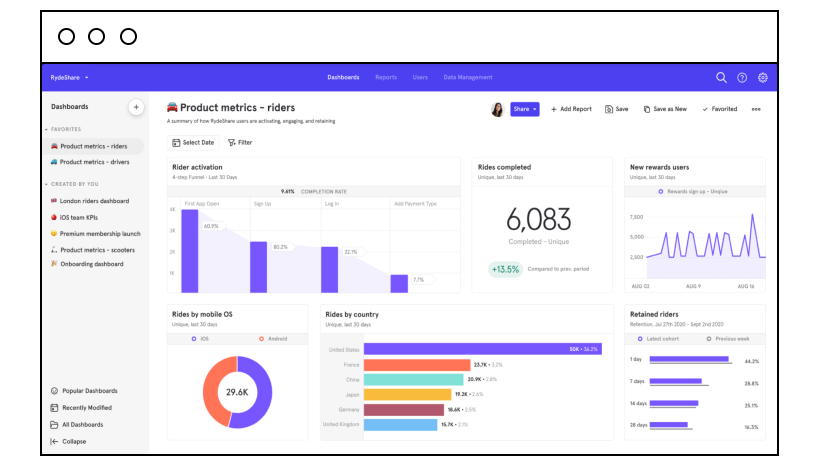
Description: Mixpanel is tracking software that helps companies measure what matters, make decisions, and build better products through data.
G2 rating: 4.4 out of 5 stars (according to 580+ reviews)
Pricing: Free (with limits); paid version starts at $25/month.
Compliance: GDPR and CCPA
Integrations: Integrates with a code to any website. Integrates with numerous A/B testing and advertising tools, various CRMs, and more.
Main features: With Mixpanel, you can measure active usage, analyze conversion and drop-off, and find retention drivers.
The most popular Mixpanel metrics include:
- Engagement
- Entry and exit pages
- Standard and custom events
- Retention
- Return
- Conversions
- Funnels
Possible pitfalls: Some users claimed the dashboard usage is confusing, and the UI is difficult. Some customers complained about slow support (can take a few days to get back to you). However, the most significant issue in terms of analytics is that sometimes you get duplicated users or problems trying to track some custom events.
StatCounter
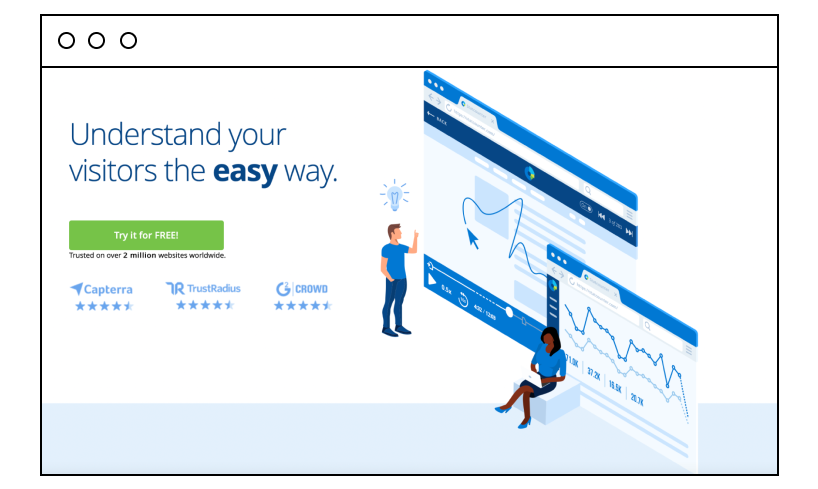
Description: Cloud-based software that helps businesses of all sizes with web analytics, data exports, fraud detection, and more.
G2 rating: 4.3 out of 5 stars (according to 100+ reviews)
Pricing: Free 30 day trial; plans from €9/month (around $10.41)
Compliance: Not fully GDPR-compliant
Integrations: Integrates with a code to any website. No third-party integrations available.
Main features: StatCounter helps you analyze traffic trends over time, track your paid traffic, and detect click fraud.
The most popular features are:
- Activity monitoring
- Pageview tracking
- Time on site tracking
- User interaction tracking
- Site search tracking
- Keyword tracking
- IP address monitoring
Possible pitfalls: StatCounter users mainly speak well of the tool. However, some of them find its free version’s functionality limited and slow, compared to its major competitor, Google Analytics.
Adobe Analytics
Description: Adobe Analytics is an analytics and multichannel data collection tool that is perfect for advanced users and larger companies. It helps you create a comprehensive view of your business by turning customer interactions into actionable insights.
G2 rating: 4.0 out of 5 stars (according to 770+ reviews)
Pricing: On request
Compliance: GDPR and CCPA
Integrations: There is an opportunity to integrate source information from almost every channel for analysis. You can use Adobe Analytics for IoT, apps, social media, and much more.
Main features: Adobe Analytics enables you to collect and measure data from multiple sources (web, email, campaigns, mobile devices, client-server applications, and most applications connected to the Internet), explore and understand this data with the help of advanced metrics, segmentation, and cross-device analytics; and get insights and predict users’ behavior; and much more.
The most popular Adobe Analytics metrics are:
- Sessions — digital analytics
- Engagement
- Entry and exit pages
- Standard and custom event tracking
- Retention
- Return
- Conversions
Possible pitfalls: The tool is one of the most expensive on the market. Also, some customers complained about its slow load speed, clunky UI, and not very timely and helpful support. Some users claimed it to be “a complicated platform that might be hard to use,” so this might not be the best choice for some small businesses and marketers that are not ready to devote much time to mastering complex tools.
Website Visitor Behavior Tracking Tools
Before you dive into visitor behavior tracking tool features, here’s a quick summary of the tools from this section. You can scroll down for detailed information about each application.

Hotjar
Description: Hotjar provides insights that show how users behave and what they feel strongly about, so product creators can deliver real value to them.
G2 rating: 4.4 out of 5 stars (according to 200+ reviews)
Pricing: Free plan; paid plans start at $39/month.
Compliance: GDPR and CCPA
Integrations: With a tracking ID, you can integrate Hotjar to any site, including the ones created with website builders like Boxmode. Hotjar also has integrations with Slack, Hubspot, Segment, Zapier, Google Optimize, Omniconvert, and Optimizely.
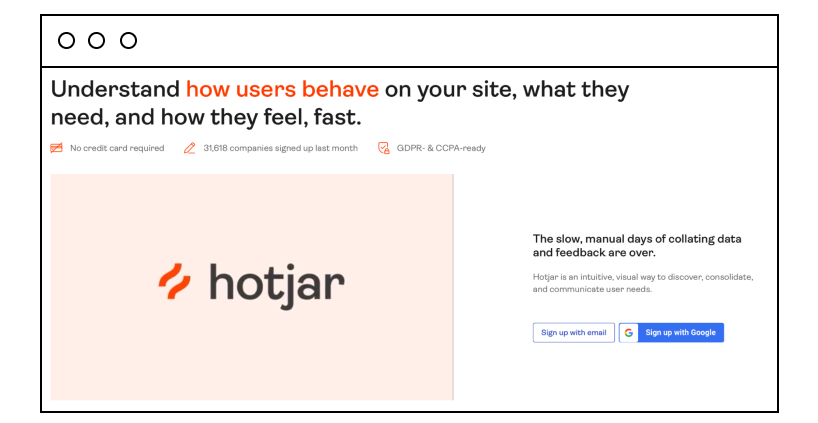
Main features: Hotjar can help in revealing your users’ online behavior. The tool can give you the full picture of how to improve your site’s UX, performance, and conversion rates.
The most popular Hotjar’s features include:
- Heat maps
- Session replays
- Monitoring
- Data segmentation
- Survey
- Click tracking
- Mouse movement
- Conversion
- Side-by-side analysis
- Webpage element analysis
Possible pitfalls: If you have no experience in selling products or marketing, it can be hard to interpret the results (such as a website visitor tracking map) and decide how to rebuild your website’s content. Also, customers noticed that there is no way to track whether or not the same visitor watched a video twice.
Crazy Egg

Description: Crazy Egg is a heat map web analytics product.
G2 rating: 4.2 out of 5 stars (according to 90+ reviews)
Pricing: Free 30-day trial for any plan; paid plans start at $24/month.
Compliance: GDPR and CCPA
Integrations: You can integrate Crazy Egg into your website using a tracking code. It also integrates with Drupal, Google Tag Manager, Joomla, Magento, Shopify, WordPress, Squarespace, Wix, and more.
Main features: Crazy Egg’s heat maps, scroll maps, and other visual reports can show you exactly how your customers interact with your site’s elements.
The most popular Crazy Egg’s features are:
- Heat maps
- Session replays
- Monitoring
- Data segmentation
- Click tracking
- Mouse movement
- Frustration tracking
Possible pitfalls: Most of the tool’s clients are satisfied with the product. However, some customers complained about the unclear signing-up process, which automatically puts you on a yearly subscription instead of a monthly subscription. Also, it can be pricey if you have many visitors per month, as Crazy Egg offers page views-based pricing.
VWO Insights
Description: VWO is an enterprise program for visitor behavior tracking and site optimization. VWO Insights product is a tool that highlights user experience bottlenecks so that you can frame your user experience problems and work on them.
G2 rating: 4.2 out of 5 stars (according to 45+ reviews)
Pricing: Free 30-day trial; paid plans upon request
Compliance: GDPR and CCPA
Integrations: VWO integrates with various analytic tools (GA, Google Tag Manager, Mixpanel, and more), CMS (WordPress, Joomla, Drupal, and CallTrackingMetrics), and ecommerce tools (Shopify, Magento, and Bigcommerce).
Main features: VWO Insights combines heat maps, session recordings, on-page surveys, and more to diagnose problem areas in your visitors’ experiences. It also works very well combined with other VWO products, such as WVO Testing and WVO Plan.
The most popular VWO Insights’ features are:
- Heat maps
- Session replays
- Data segmentation
- Conversion opportunities
- Mobile device analysis
- Data quantification
- Webpage element analysis
Possible pitfalls: Some customers reported the tool’s navigation and user-experience issues.
Kissmetrics
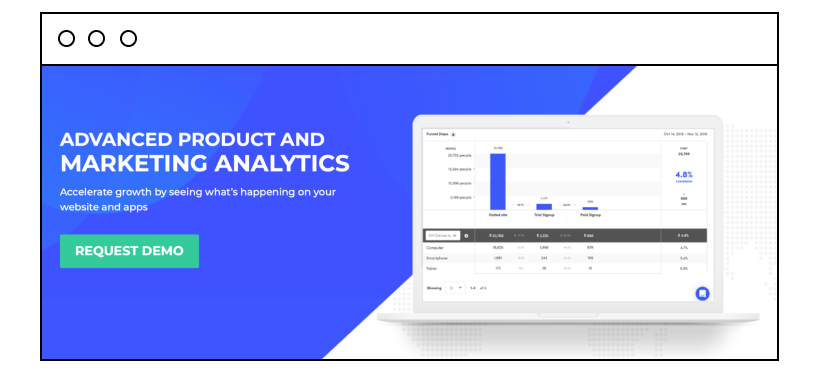
Description: Kissmetrics provides advanced analytics functionality for SaaS and ecommerce businesses.
G2 rating: 4.0 out of 5 stars (according to 160+ reviews)
Pricing: 7-day free trial; paid plans start at $299/month (billed annually).
Compliance: GDPR
Integrations: Kissmetrics integrates with many tools, such as Mailchimp, VWO, Facebook Ads, WordPress, Shopify, and many others. View the full list.
Main features: Kissmetrics is a visitor tracking tool for websites of ecommerce brands and SaaS vendors. It offers behavioral analytics, segmentation, and email campaign automation.
Its most popular metrics include:
- Sessions — digital analytics
- Engagement
- Entry and exit pages
- Standard and custom events
- Segmentation
- Retention
- Return
- Conversions
- Funnels
Possible pitfalls: The tool can be pricey for small business owners. The main users’ complaints are about poor customer support, unfriendly UI, and lack of report automation.
Website Visitor Identification Tools
Below, you can find a comparison chart of the tools from this section. Full solution descriptions are, as usual, below the table.
Note: Due to many employees working remotely during COVID-19, these tools can show less accurate B2B tracking data. Also, finding contacts only works mostly for business email addresses, not for Gmail or other private email addresses.
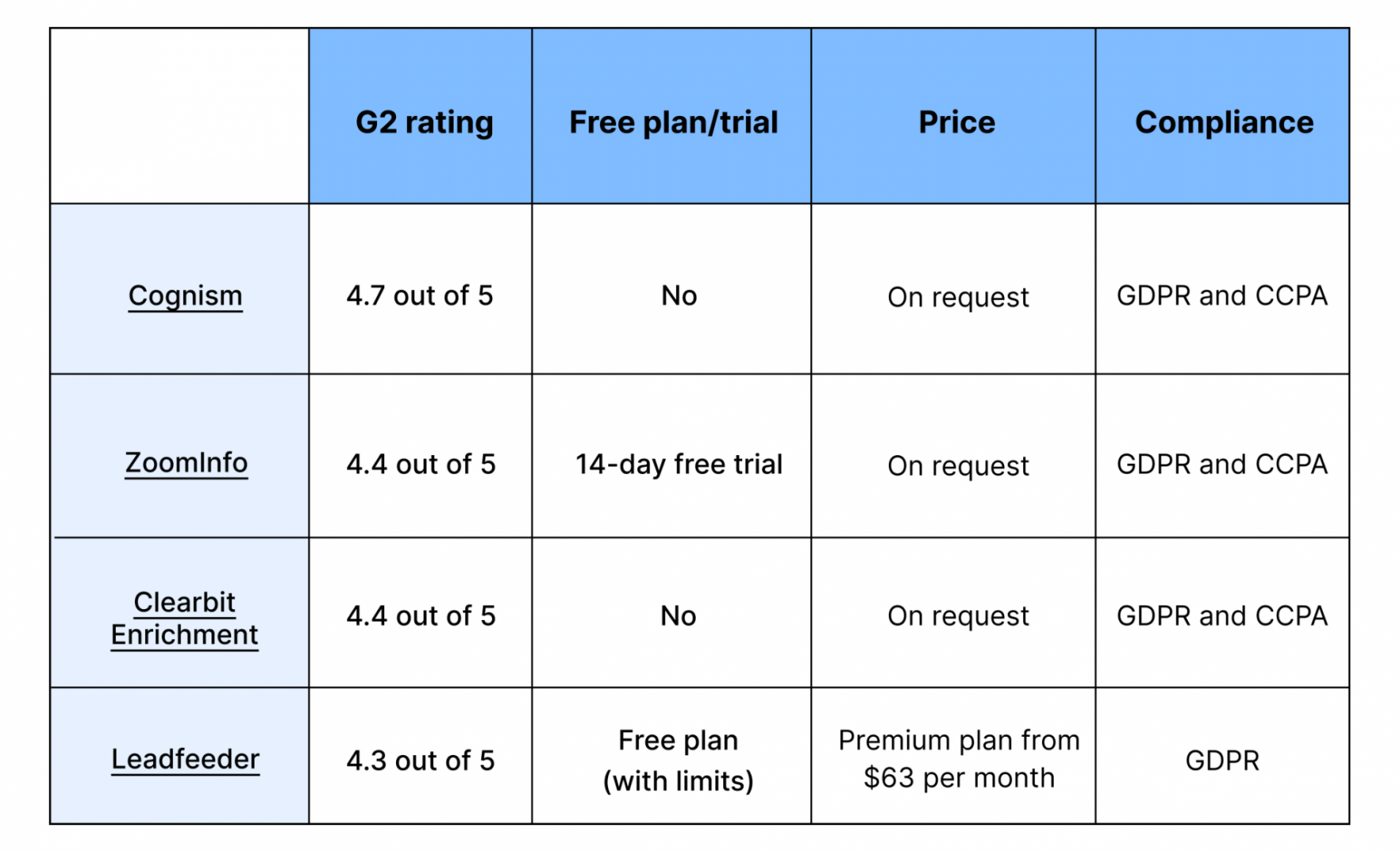
Cognism
Description: A lead intelligence software that helps companies find and engage with their ideal buyers via phone, email, and LinkedIn.
G2 rating: 4.7 out of 5 stars (according to 180+ reviews)
Pricing: On request
Compliance: GDPR and CCPA
Integrations: Cognism integrates with many tools, such as Outreach, HubSpot, Salesforce, Pipedrive, Chrome, and many more. View the full list.
Main features: Cognism helps businesses find and engage with their prospects by providing premium company and contact information, including firmographics, technographics, sales trigger events, verified business emails, intent data, and phone-verified mobile numbers.
The most popular Cognism features are:
- Contact data availability
- Company data availability
- Industry research availability
- Contact data accuracy
- Company data accuracy
Possible pitfalls: Most of the tool’s clients are satisfied with the product. However, since it doesn’t offer a free trial, you may not fully understand the product from the demo. Also, some customers complained about outdated information about leads.
ZoomInfo

Description: ZoomInfo offers a technology that provides an accurate, all-around view of customers, prospects, and opportunities.
G2 rating: 4.4 out of 5 stars (according to 5000+ reviews)
Pricing: 14-day free trial; paid plans upon request
Compliance: GDPR and CCPA
Integrations: Zoominfo integrates with Salesforce, HubSpot, Microsoft Dynamics, Outreach, SalesLoft, and Zoho.
Main features: ZoomInfo offers territory planning support, lead scoring, sales prospecting, targeted outreach, and more.
The most popular Zoominfo features are:
- Contact data availability
- Company data availability
- Industry research availability
- Contact data accuracy
- Company data accuracy
Possible pitfalls: Some users reported the tool to be slow and to give sometimes inaccurate data. Also, they mentioned problems with getting out of the Zoominfo contract. You have to cancel your subscription via email one month before your contract is set to renew; otherwise, they auto-renew it.
Clearbit Enrichment
Description: A tool that helps you to automatically enrich leads with contact-level and firmographic data to power smarter lead scoring, lead routing, and more personalized email campaigns.
G2 rating: 4.4 out of 5 stars (according to 500+ reviews)
Pricing: Pricing is flexible and on request, based on your CRM database size, monthly web traffic, and monthly contact creation.
Compliance: GDPR and CCPA
Integrations: Salesforce, Marketo, HubSpot, Pardot, Segment, and more
Main features: Clearbit helps you know who is visiting your website, who you should target, and how to personalize campaigns while predicting churn before it happens.
The most popular Clearbit features are:
- Contact data availability
- Company data availability
- Industry research availability
- Contact data accuracy
- Company data accuracy
- CRM integration
- Data cleaning/enrichment
Possible pitfalls: Some clients were unhappy with tracking results, claiming them to be outdated.
Leadfeeder
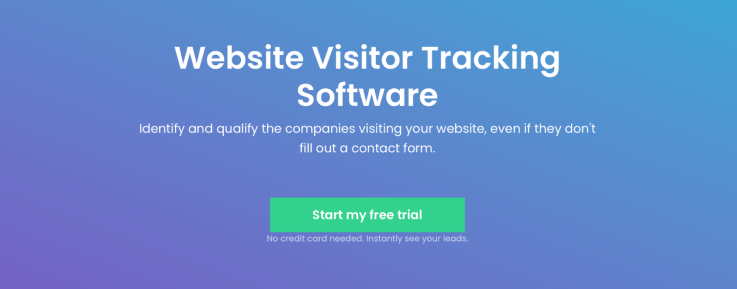
Description: Leadfeeder is a tool that lets you identify your website visitors and helps you convert promising visitors into sales leads. It offers B2B website visitor tracking software that shows companies that have already visited your website, how they found you, and more.
G2 rating: 4.3 out of 5 stars (according to 500+ reviews)
Pricing: Free basic version (with limits); premium plan starts at $63 and has a 14-day free trial and can be downgraded to basic version after that.
Compliance: GDPR
Integrations: Leadfeeder integrates with many major platforms, such as Pipedrive, Mailchimp, Salesforce, Zoho, Zapier, GA, ActiveCampaign, HubSpot, and more.
Main features: Leadfeeder provides identification and visitor tracking tools to help you determine and convert the leads.
The most popular Leadfeeder’s features are:
- Contact data availability
- Company data availability
- Industry research availability
- Contact data accuracy
- Company data accuracy
Possible pitfalls: Leadfeeder customers say that free version features are very limited.
Putting web visitor tracking to work
Today, brands bombard their consumers with more marketing messages than ever. However, these messages are not always accurate. As a result, consumers get irritated with the smallest signs of marketing campaigns or sales pitches. So, brands have to put even more effort into getting them converted.
But how do you know exactly what your consumers need? — For starters, get more out of what you’re currently doing.
Website visitor tracking tools help you deeply understand what you’re currently doing and enable you to guess your prospects’ needs before they’ve even initiated contact. After you find this out, you can get to optimizing your site and refining your marketing campaigns to boost conversions and create an amazing experience for visitors.
